Save to My DOJO
Table of contents
With the release of VMware vSphere 7.0, VMware provided a revolutionary new version of VMware vSphere in lock-step with modern infrastructure supporting modern application development. With VMware vSphere 7.0, VMware introduced ESXi with a fully integrated Kubernetes platform. Application developers greatly benefit from the new functionality allowing them to develop modern applications and consume infrastructure from vSphere by using native Kubernetes APIs.
With the release of VMware vSphere 7 Update 1, VMware has built upon the new features introduced in vSphere 7.0 and significantly polished the offering. VMware vSphere 7 Update 1 is most likely the target of upgrade paths for organizations running legacy versions of vSphere that want to benefit from a modern infrastructure platform supporting modern application development. This post will take a detailed look at What’s new in vSphere 7 Update 1 and see how VMware has extended the capabilities and features of vSphere 7.0 with this release.
What’s new in vSphere 7 Update 1
With the release of vSphere 7 Update 1, VMware has taken the newly introduced features and capabilities of vSphere 7.0 and extended these so that organizations running more traditional vSphere environments and those building modern applications will benefit from its new features. Let’s consider the following new features and enhancements with vSphere 7 Update 1.
- New vSphere with Tanzu offering
- New Enterprise Workload features
- VMware vSAN 7 Update 1
- VMware Cloud Foundation (VCF) v4.1
1. New vSphere with Tanzu Offering
A paradigm shift is happening in the technology industry across the board as businesses focus on modernizing their applications. Modernizing applications generally involves developing microservices that run in containerized workloads. Kubernetes has emerged as the clear winner in this space and the defacto standard of container orchestration. Businesses are now focusing on how they can implement and use Kubernetes-driven containers for their microservices.
VMware has recognized this shift in the industry and has answered the demand of enterprise environments worldwide who need an effective, efficient, and easy way to provision Kubernetes as part of their application stack. The exciting new technology that made its way into vSphere 7 began with key announcements at VMworld 2019. VMware then announced Project Pacific as a complete overhaul and re-architecture of the vSphere platform. The new vSphere 7.0 architecture provides natively integrated Kubernetes as part of vSphere, rather than a bolt-on product or solution that integrates with vSphere.
While Project Pacific has brought about powerful new Kubernetes capabilities native to vSphere 7.0, this new functionality was only available as part of VMware Cloud Foundation (VCF) with Tanzu. One of the significant new features as part of vSphere 7 Update 1 is the introduction of VMware vSphere with Tanzu. VMware is touting the new VMware vSphere with Tanzu as the “fastest way to get started with Kubernetes workloads.” What is significant about vSphere with Tanzu as part of vSphere 7 Update 1?
VMware vSphere with Tanzu is significant in that organizations can now deploy Tanzu Kubernetes Grid clusters on top of native vSphere environments, using vSphere networking. It allows deploying TKG without the need for VMware Cloud Foundation or NSX-T. VMware Cloud Foundation is the fully-featured virtualization stack that allows deploying all components seamlessly and efficiently. However, for those running more traditional environments with vSphere Distributed Switches (vDS) for networking without NSX and NSX load balancers, requiring VCF for TKG cluster was undoubtedly a barrier to entry.
The new vSphere with Tanzu helps to open the door for organizations running over 70+ million traditional workloads in VMware vSphere to the possibility of quickly getting up and running with vSphere with Tanzu TKG clusters. What are the features of vSphere with Tanzu?
- It is quick and easy to provision – VMware notes that provisioning a vSphere with Tanzu Kubernetes infrastructure tasks as little as one hour
- Developers will be able to have a fully self-service infrastructure – The new vSphere with Tanzu Kubernetes offers a self-service style interface with the normal Kubernetes namespace constructs. Any existing development processes will easily transition to using vSphere with Tanzu and current CI/CD pipelines in place.
- Standard, familiar vSphere interface – This allows vSphere administrators with years of familiarity and experience with the vSphere interface to be at home managing and maintaining Kubernetes-based applications using vSphere with Tanzu. It is merely a part of the well-known vSphere interface.
Tanzu networking with built-in vSphere Distributed Switch (vDS)
Instead of requiring a VMware NSX-T configuration for attaching your Tanzu Kubernetes clusters, customers can now connect TKG clusters directly to vSphere Distributed Switches (vDS). It reduces complexity for those who do not want or need VMware NSX-T only to provision TKG clusters in their environment. It also opens the door for using a third-party network load balancer to connect the environment to external services.
When configured with the native vSphere network stack using vSphere Distributed Switches, all hosts from the cluster connect to a vDS in the vSphere environment. It provides connectivity to Kubernetes workloads and control plane virtual machines and requires a third-party load balancer to provide connectivity. It contrasts with VMware NSX-T Data Center, which provides the built-in NSX Edge load balancer for connectivity to external services and users.
Configuring the vSphere Distributed Switch for use with vSphere with Tanzu is straightforward. It involves configuring the vDS with the appropriate port groups, including:
- Management – The management vDS port group will carry traffic between the Supervisor cluster control plane and the vCenter Server.
- Frontend – The frontend network supplies the virtual IP ranges for the TKG grid clusters
- Workload – Your workloads are the actual Kubernetes nodes. You can use one or more distributed port groups as Workload networks. The network that provides connectivity to the Kubernetes control plane VMs is called the Primary Workload network.
In vSphere with Tanzu, VMware has opened the door to independent third-party load balancer solutions. HAProxy is the first load balancer solution out of the gate supported with vSphere with Tanzu. The HAProxy provides a free solution that allows deploying a third-party load balancer for vSphere with Tanzu. Organizations deploy HAProxy as an OVA appliance in the vSphere environment. Once administrators deploy the virtual appliance, they complete the configuration and deployment of the vSphere with Tanzu configuration with the built-in wizard. The wizard requires the HAProxy is in place before setup can proceed.
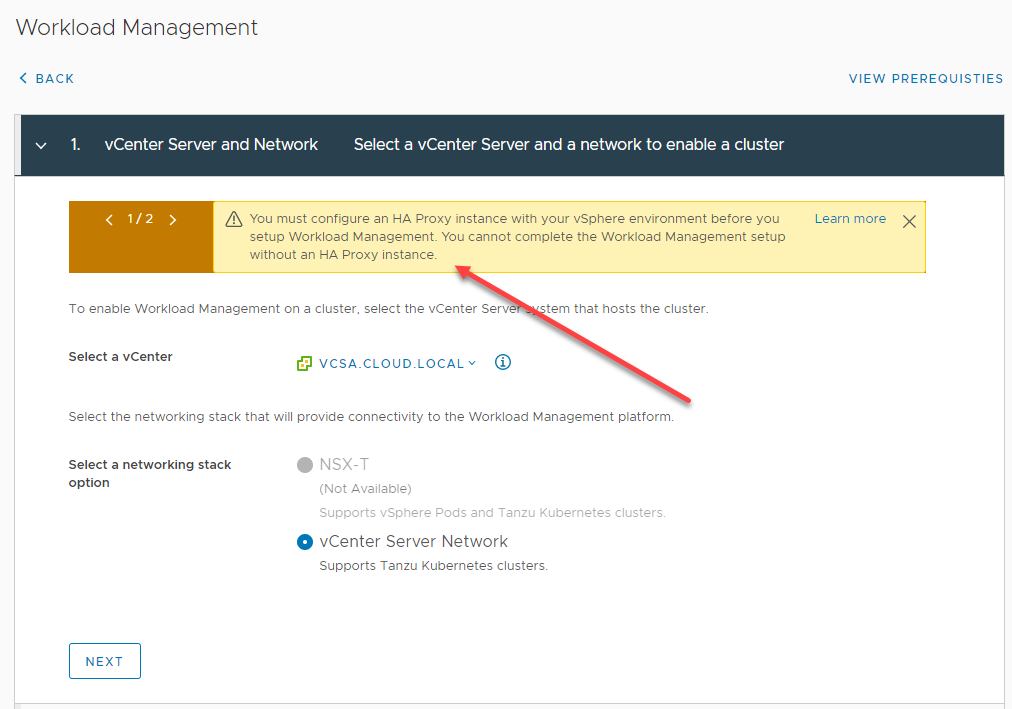
Using the Workload Management Wizard to deploy TKG with the HAProxy
Below is a high-level overview of the network architecture using vSphere with Tanzu.
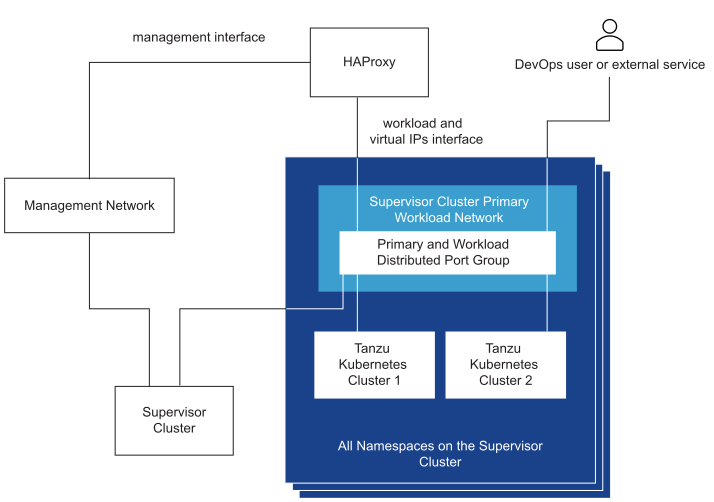
VMware vSphere with Tanzu supervisor cluster with one network
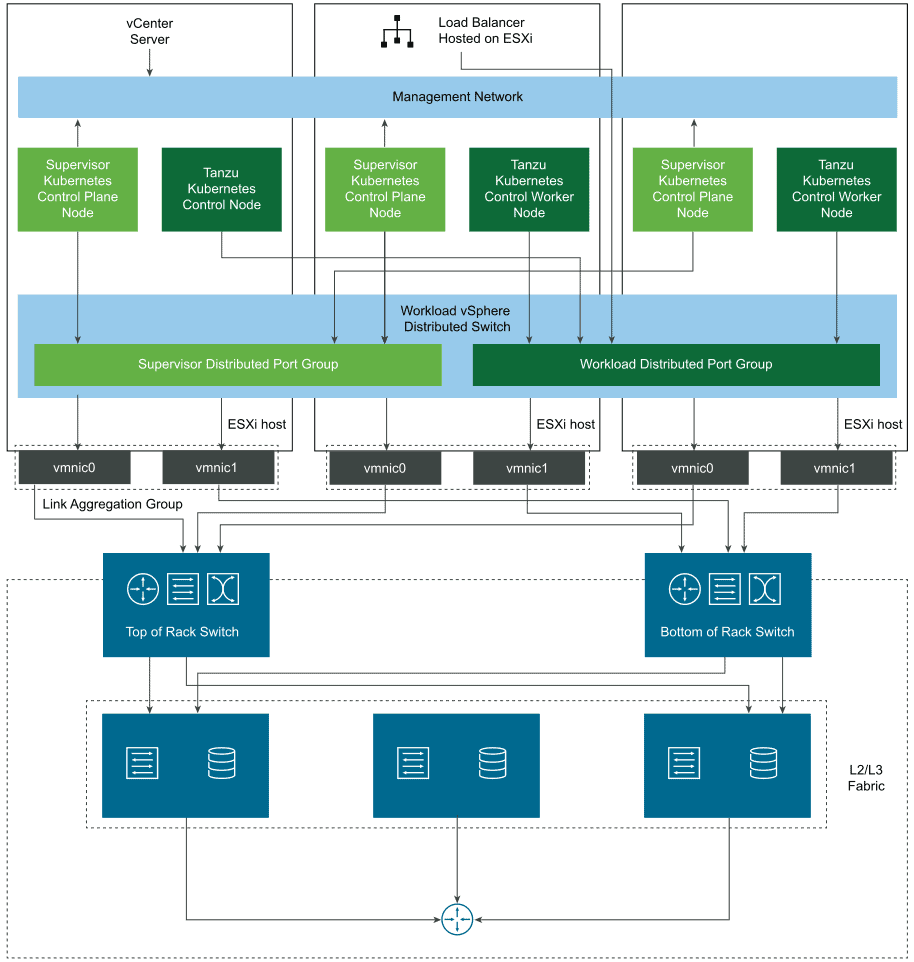
vSphere with Tanzu network flow
The new vSphere with Tanzu provides many options for existing customers to architect and deploy the networking stack to back the Tanzu Kubernetes Grid clusters. VMware still recommends using VMware Cloud Foundation (VCF) with Tanzu for fully-featured environments with complex requirements. It includes using the advanced networking features of VMware NSX-T. However, vSphere with Tanzu will allow organizations with traditional deployments to deploy Kubernetes in their environment quickly.
2. New Enterprise Workload Features
While the focus with the new vSphere 7 Update 1 release is primarily on modern applications, VMware has not forgotten traditional workloads. The vSphere 7 Update 1 contains many updated features and capabilities that benefit the more traditional enterprise data center running conventional virtual machines. What are some of these new enhancements when it comes to traditional virtual machine workloads?
- VMware has updated vSphere 7 Update 1 with support for new so-called “monster VMs” that sport 24 terabytes of memory and 768 vCPUs.
- Updated vSphere cluster configuration maximums – VMware vSphere 7 Update 1 supports newly extended vSphere cluster configuration maximums, including support for 96 hosts per cluster. It extends beyond previous vSphere releases by 50%.
- vSphere Lifecycle Management (vLCM) – The new vSphere Lifecycle Management is a powerful new lifecycle management tool introduced with vSphere 7. VMware is committed to the new vLCM tool with vSphere 7 Update 1. It has newly added features and capabilities that extend lifecycle management capabilities with vSphere 7 Update 1. With vLCM in vSphere 7 Update 1, customers can now manage NSX-T, vSAN, and new firmware offerings and management.
- VMware vCenter Connect – VMware realizes that customers are increasingly using cloud environments such as VMware Cloud on AWS to extend their on-premises environment with hybrid cloud functionality. The new vCenter Connect feature allows organizations to manage VMware Cloud on AWS or other cloud-hosted vCenter Server by using their on-premises vCenters in a single-pane-of-glass interface.
3. VMware vSAN 7 Update 1
Software-defined storage (SDS) is one of the paradigm shifts in the modern data center. The days of legacy storage arrays are numbered, at least in most general use cases. Software-defined storage provides tremendous benefits when compared to the traditional equivalent. Since its release, VMware vSAN has been a wildly popular option for organizations looking to transition to using software-defined storage and take advantage of the many benefits offered by VMware vSAN.
With each release of VMware vSphere, VMware has continued to improve the feature list of VMware vSAN to provide a “best of breed” modern storage solution capable of backing both traditional and modern applications, including those using Kubernetes. VMware vSphere 7 Update 1 is no exception here as VMware has added many new features in vSphere 7 Update 1 that help make vSAN 7 Update 1 the most powerful and capable release to date.
New features of vSAN 7 Update 1 include the following:
- vSAN Data Persistence Platform
- HCI Mesh
- Improved vSphere Lifecycle Manager (vLCM)
- Compression only option
- Shared Witness capability
- Improved enterprise file services
- vSAN IO Insight
- Data encryption in-flight
- Secure Disk wipe
- vSAN Layer 3 GUI network gateway configuration
- Faster host reboots
Let’s highlight a few of the significant features listed, including vSAN Data Persistence Platform, HCI Mesh, improved vSphere Lifecycle Manager (vLCM), Compression only space efficiency, and shared witness capability.
vSAN Data Persistence Platform
The vSAN Data Persistence Platform allows extending vSAN storage capabilities to support new modern applications’ persistent storage needs using Kubernetes. The new vSAN Data Persistence feature is a new framework that allows third-party partners to deploy their applications into the Supervisor Cluster. Partner-developed applications can directly access the vSAN storage layer using a technology VMware refers to as VMware Direct. It allows the applications to benefit from the direct access provided by the vSAN direct and have visibility into infrastructure-driven operations such as lifecycle management.
HCI Mesh
The new HCI Mesh capability as part of VMware vSAN 7 Update 1 is an exciting new capability that allows one vSAN cluster to use storage capacity from another vSAN cluster. Organizations with many vSAN clusters may have individual clusters that contain “stranded” storage capacity. Other vSAN clusters may have CPU capacity left but may have exhausted the local vSAN datastore’s available storage. With HCI Mesh, organizations can pool the resources of multiple vSAN clusters. VMware vSAN 7 Update 1 clusters by way of HCI Mesh are allowed to remotely mount datastores from other vSAN clusters within the vCenter inventory.
An added benefit of this new feature is that it makes use of native vSAN storage communication. It is not an extension of the file services provided by vSAN. All of the storage policy-based management (SPBM) benefits and features extend to HCI Mesh vSAN storage for consistent and predictable behaviour.
Improved vSphere Lifecycle Manager (vLCM)
The new vSphere Lifecycle Manager (vLCM) is the replacement for the traditional vSphere Update Manager (VUM) that vSphere administrators have grown accustomed to for lifecycle management in vSphere. The vLCM tool is superior to VUM in many different ways and provides a declarative approach to managing your vSphere environment. The vSphere administrator can use the vLCM tool to create a desired state for the vSphere cluster, then vLCM brings the cluster into compliance with the “image” defined.
With vSphere 7 Update 1, VMware has introduced new features for the vLCM tool, making it even more powerful. With the vSphere 7 Update 1 vLCM release, VMware has added Lenovo hardware support for firmware remediation. In addition to the added hardware support, vLCM in vSphere 7 Update 1 adds support for NSX-T lifecycle management and added scalability.
Compression only space efficiency
New with VMware vSAN 7 Update 1 is a new option for space-saving efficiency that many have wanted for quite some time. Before vSphere 7 Update 1, customers could not separate Deduplication and Compression as storage efficiency options for vSAN. It was a single option that only allowed selecting both technologies. However, new with vSAN 7 Update 1, customers now can choose Compression only as an option without the need to enable deduplication.
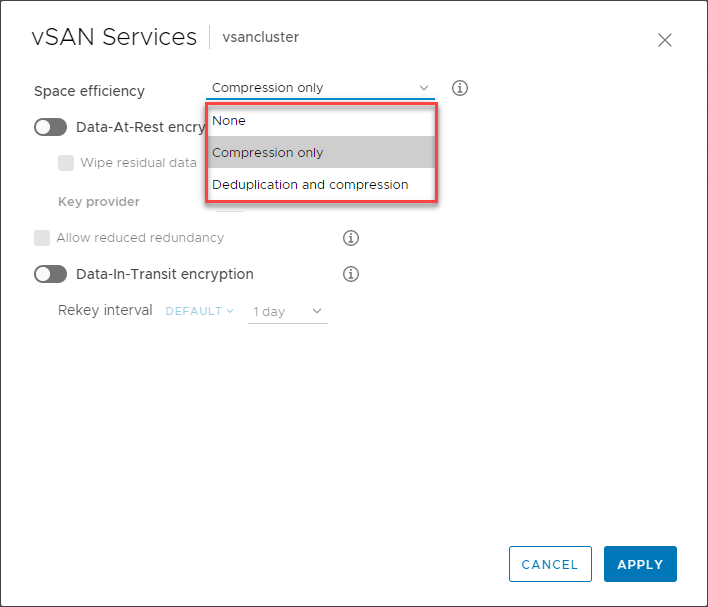
New compression-only option in vSAN 7 Update 1
There were only a couple of real-world use cases that truly benefited from deduplication enabled along with compression, such as VDI environments. For most general-purpose workloads, deduplication brings little if any benefit. It also introduces CPU overhead and takes out an entire disk group with a single drive failure as VMware vSAN spreads the deduplication information across all drives in the disk group. The new option in vSAN 7 Update 1 gives organizations more granularity in the space efficiency technologies they choose for their particular environment that better matches specific use cases.
Shared Witness
VMware vSAN 7 Update 1 has introduced a new welcomed feature to reduce the infrastructure footprint and resource needs. New with vSAN 7 Update 1, VMware has introduced the capability to have a shared witness node for multiple vSAN clusters. As you may know previously, each stretched vSAN cluster required a dedicated witness node for quorum. It will help to simplify the layout of vSAN infrastructure, especially in edge or ROBO installations.
Other new vSAN 7 Update 1 features
There are many other new features to speak of in vSAN 7 Update 1, including improved enterprise file services, vSAN IO Insight, data encryption in-flight, secure disk wipe, vSAN layer 3 GUI network gateway configuration, and faster host reboots. The new vSAN 7 Update 1 release will undoubtedly be a worthy upgrade for environments using legacy vSAN versions for business-critical workloads.
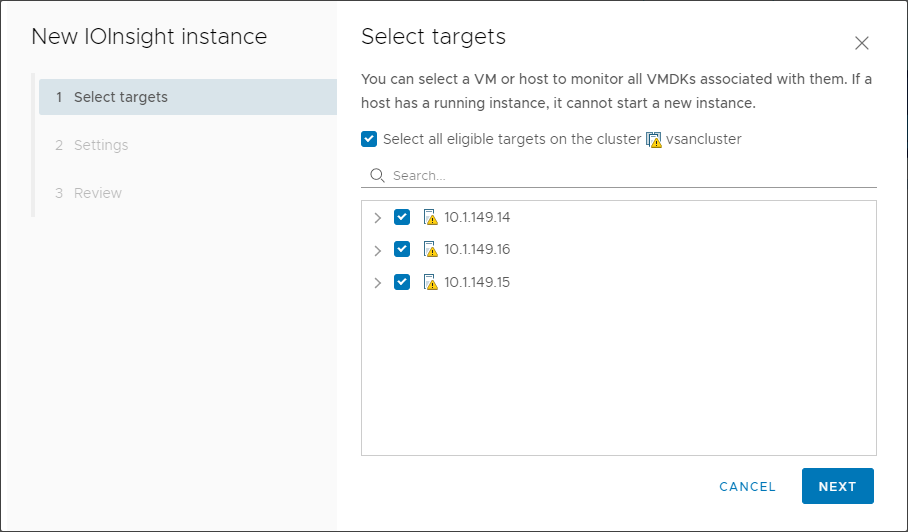
New vSAN 7 Update 1 IO Insight
VMware Cloud Foundation (VCF) v4.1
VMware Cloud Foundation (VCF) provides a holistic infrastructure stack for organizations to run their business-critical workloads. It allows vSphere administrators to provision a turnkey software-defined data center using VMware solutions. VMware Cloud Foundation provides many unique benefits for your organization’s business-critical workloads, including:
- Standardized architecture – With VCF, organizations can provide a standardized environment that provides predictability, performance, stability, and all the latest features for modern applications
- Simplified management – VCF allows deploying complex solutions using a turnkey deployment process that enables a streamlined approach, both for deployment and management
- Scale and efficiency – Using VMware Cloud Foundation, organizations can quickly deploy, manage, and scale their vSphere solutions, both on-premises and in cloud environments. VCF provides an abstraction layer that allows workloads to be run in any cloud, anywhere. If workloads need repatriated on-premises, organizations can accomplish this without refactoring applications
- Security benefits – VMware’s cutting-edge NSX-T platform is a native part of the VCF solution. It brings all of the intrinsic security benefits to your environment when using VCF.
- Modern applications – VCF is the premier solution for running VMware Tanzu Kubernetes and offers the most advanced options for organizations looking to deploy TKG clusters in their environment.
New VMware Cloud Foundation v4.1 benefits include:
- vSAN Data Persistence Platform
- VMware Cloud Foundation Remote Clusters
- Other integrations and benefits
New vSAN Data Persistence as part of VCF v4.1
VMware Cloud Foundation v4.1 assumes the underlying benefits of technologies included in the VCF stack, including the new capabilities and features of vSAN 7 Update 1. One of those benefits is the vSAN data persistence platform. Now, with VCF v4.1, organizations can benefit from the framework for modern stateful service providers to integrate with vSAN for data persistence needs. Since VCF offers the most advanced features for organizations running modern applications using Kubernetes, the new underlying vSAN Data Persistence features allow third-party vendors to take full advantage of current capabilities with VCF.
VMware Cloud Foundation Remote Clusters
With the new VMware Cloud Foundation Remote Clusters capability, organizations can extend a VCF workload domain to operate at a remote site separate from the central VCF management cluster. It opens up many possibilities for an edge, ROBO, and other locations to benefit from VCF capabilities. It will allow organizations to benefit from a seamless cloud operating model that includes the data center and remote edge locations. Benefits will include a standardized operations model and lifecycle management across locations.
Other features and benefits
There are many other additional features to note with VMware Cloud Foundation (VCF) v4.1. These include vVols as principal storage in the VCF Workload Domain, vRealize Suite 8 Automation, SDDC Manager enhancements, and VMware Skyline support for VCF. All of these new features allow VCF to keep pace with the latest innovations and functionality provided by VMware solutions.
Concluding Thoughts
The VMware vSphere 7 Update 1 release is massive, touting many new features and capabilities for your business. VMware has provided updates in all areas of the vSphere product, including traditional virtual machines and modern workloads running in Tanzu Kubernetes Grid clusters. The new vSphere with Tanzu offering will allow countless organizations to take advantage of Kubernetes without changing network architecture or introducing NSX-T to run Tanzu Kubernetes. Leveraging standard vSphere Distributed Switches and using a third-party load balancer solution, organizations can effectively provision vSphere with Tanzu in under an hour in most environments.
New features and capabilities in the more traditional vSphere data center will allow organizations to continue delivering performance and scalability in the traditional enterprise. VMware vSAN 7 Update 1 provides many new features that will enable organizations to more effectively use storage space, scale vSAN, and support modern workloads such as Kubernetes. Additionally, it reduces the infrastructure footprint needed to deploy vSAN 7 Update 1 stretched clusters by consolidating the witness node appliance for multiple vSAN clusters.
VMware Cloud Foundation (VCF) v4.1, in conjunction with VMware vSphere 7 Update 1, provides the next evolution of VCF functionality for organizations to continue delivering the full SDDC stack for running business-critical workloads in the environment. It includes taking advantage of the latest solution releases, such as vSAN 7 Update 1, and new features such as the VCF Remote Clusters, which will help reduce infrastructure and provide a seamless management experience of VCF across locations.
VMware vSphere 7 Update 1 is a landmark release in the evolution of VMware vSphere and will allow customers to provide the latest features, functionality, and capabilities intuitively. It will enable customers to concentrate on delivering applications to business stakeholders without worrying about the underlying infrastructure.


Not a DOJO Member yet?
Join thousands of other IT pros and receive a weekly roundup email with the latest content & updates!









